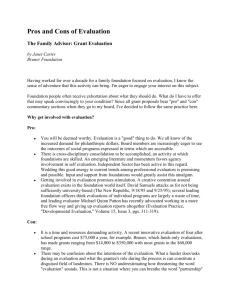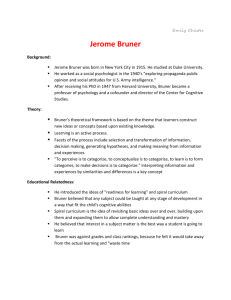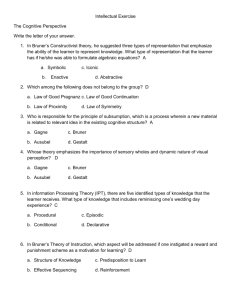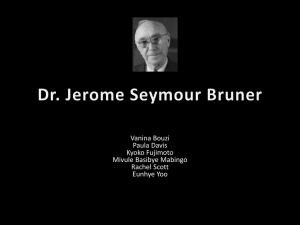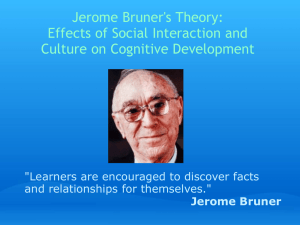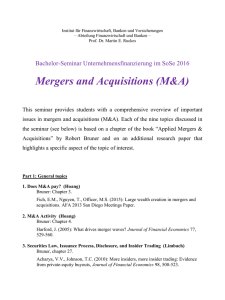+ 2 (,1 1/,1(
advertisement
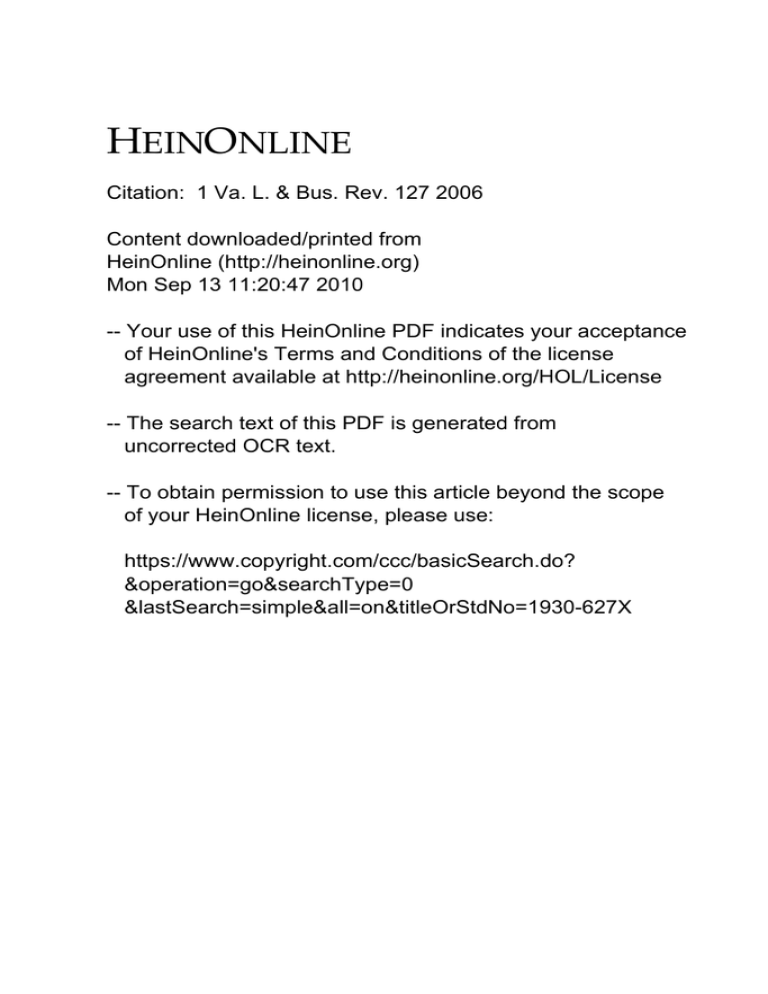
+(,121/,1( Citation: 1 Va. L. & Bus. Rev. 127 2006 Content downloaded/printed from HeinOnline (http://heinonline.org) Mon Sep 13 11:20:47 2010 -- Your use of this HeinOnline PDF indicates your acceptance of HeinOnline's Terms and Conditions of the license agreement available at http://heinonline.org/HOL/License -- The search text of this PDF is generated from uncorrected OCR text. -- To obtain permission to use this article beyond the scope of your HeinOnline license, please use: https://www.copyright.com/ccc/basicSearch.do? &operation=go&searchType=0 &lastSearch=simple&all=on&titleOrStdNo=1930-627X VIRGINIA LAW & BUSINESS REVIEW VOLUME 1 SPRING 2006 NUMBER 1 BOOK RE VIEW ROBERT F. BRUNER, DEALS FROM HELL: M&A LESSONS THAT RISE ABOVE THE ASHES Edmund W. Kitcht" IN TRO D UCT 1O N ...................................................................................................... 127 I. SUM NIA RY O F THE B O OK ................................................................................... 128 II. D iSC USSiO N ........................................................................................................ 136 C O N CL USIO N ........................................................................................................... 140 INTRODUCTION T RANSACTIONS to buy or sell whole businesses are among the most exciting and challenging events to confront the business manager. In the space of a few days, it is possible to buy or sell a business that took decades to develop. Unlike tiring and tedious problems of product design, organizational efficiency, personnel management, marketing, and legal compliance, a merger transaction usually forces a manager to make decisions in a compressed timeframe. These decisions require that the manager possess an effective understanding of valuation, taxation, regulation, antitrust law, public relations, government relations with national, regional, and local jurisdictions, corporate and securities law, and the future of an industry or industries. If the transaction has trans-national dimensions, this understanding must involve multiple national cultures, markets, and legal systems. t Mary and Daniel Loughran Professor of Law and E. James Kelly, Jr. - Class of 1965 Research Professor, University of Virginia School of Law. For outstanding research assistance, 1 thankJenny Marshall of the University of Virginia Law School Class of 2006. Copyright © 2006 Virginia Law & Business Review Association HeinOnline -- 1 Va. L. & Bus. Rev. 127 2006 128 Virginia Law & Business Review 1:127 (2006) Robert F. Bruner, who is Dean, Charles C. Abbott Professor of Business Administration, and Distinguished Professor of Business Administration at the University of Virginia's Darden Graduate School of Business Administration, has taught a course on mergers and acquisitions for many years. He is an academic who bridges the world of finance scholarship and the problems confronting those practitioners who must make actual decisions in real time in the course of these transactions. His teaching and scholarship combine a mastery of the academic finance literature with detailed knowledge of many actual transactions developed as a result of compiling numerous business school case studies for instructional use. I. SUMMARY OF THE BOOK Dealsfrom Be//is a product of Dean Bruner's teaching and research.1 The book consists of four parts. First, Bruner reviews the academic literature regarding whether deals are beneficial to the parties involved, and he identifies the general characteristics of the deals that fail (Chapters 2-3). Second, he summarizes research on effective management responses to real disasters (Chapter 4). Third, Bruner summarizes ten case studies of mergers that went badly awry, the "deals from hell" (Chapters 4-14). And fourth, in his conclusion, Bruner criticizes the style of management that attempts to deliver consistent earnings growth and to obtain a relatively high priceearnings ratio for the company's stock. He associates this management style with a corporate culture that invites 'deals from hell.' Bruner writes for the 'practitioners' of M&A transactions, those managers 2 who are called upon to make decisions regarding these business deals. Bruner's message is that such transactions offer both promise and peril, and his objective is to provide guidance that can help a manager make decisions that offer promise and avoid peril. The book is also of interest to supporting professionals in M&A transactions because it can help those professionals better understand the issues that confront their clients' managers. Chapter 2 is a review of the reported studies of the outcomes from M&A transactions. These are event studies, which examine the subsequent stock market performance of the surviving public companies to determine the returns to the shareholders in relation to the returns to the market as a 1".BRUNER, 1. ROBERT 2. (2005) [hereinafter E.g., id. at 10. DEALS F-ROM HELL: M&A LESSONS TIIAi RISE ABOVE TIIE ASIIES BRUNER, DEALSI. HeinOnline -- 1 Va. L. & Bus. Rev. 128 2006 1:127 (2006) Robert F Bruner, Deals from Idell whole. 3 On one hand, the average return to the buyers in the transactions is equal to the average return to the market. 4 Sellers, on the other hand, receive a premium. 5 As a result, the combined return from these transactions is greater than the average return.6 Thus, it is reasonable to infer that these transactions create economic value. From Chapter 2, Bruner draws a central theme of the book, M&A transactions are not bad as a class. Rather, there are M&A transactions that make sense for the buyer and transactions that are disasters for the buyer. To use Bruner's words, "all transactions are local."' That is, whether or not a transaction is a good idea depends on the specific facts surrounding that transaction. Bruner argues that the resulting average rate of return for M&A transactions is not surprising even though there is much conventional wisdom declaring that M&A transactions do not pay.8 M&A transactions are just like other important decisions that managers make: decisions about whether to build a new factory, design a new product, deploy an advertising campaign, or hire more salesmen. On average, the decisions that managers make turn out to be, well, average. The evidence does not support the view that managers do relatively less well in making decisions about M&A transactions than they do in making other decisions about the businesses they manage. 9 I agree with Bruner that the idea that buyers make poor investment decisions in M&A transactions is widespread, if not entirely conventional. Surprisingly, it turns out to be difficult to document its widespread nature. Bruner relies on the business press to verify that the view is conventional.'( I believe it is also widespread in the legal academy, but it is not easy to find it expressly stated in law review articles. The legal literature has been far more concerned with the seller's ability to extract the highest price (or to block the transaction altogether) than the foolishness of the buyer who pays it." The argument that managers of buyers make particularly poor decisions in M&A transactions, at least from a shareholder perspective, goes as follows. 3. 4. 5. 6. 7. 8. 9. 10. 11. Id.at Id.at Id.at Id.at 19. 22. 20. 22-23. E.g., Id. at 24. Id.at 38. Id. at 41. Id.at 14-16. See, e.g., Lucian Arve Bebchuk, Toward Undistorted Choice and Equal Treatment in Corporate Takeovers, 98 HARV.L.REv. 1695 (1985); Lucian Are Bebchuk, The Sole Owner Standardfor TakeoverPolig', 17 J.Li;ALSIUD. 197 (1988). HeinOnline -- 1 Va. L. & Bus. Rev. 129 2006 130 Virginia Law & Business Review 1:127 (2006) Managers can take advantage of monitoring slack to use corporate resources to benefit themselves rather than the shareholders, typically by using available corporate cash to expand their empire rather than to pay dividends. M&A transactions are a particularly good way for managers to expand rapidly. While it may take years to expand the managerial empire by building a business internally, managers can spend billions in the blink of an eye in an M&A transaction. This argument is based upon, but not faithful to, the argument in Michael Jensen's influential article Ageng Costs of Free Cash Flow, Corporate Finance, and Takeovers. In that article Jensen asserts that "the theory [of free cash flow] implies managers of firms with unused borrowing power and large free cash flows are more likely to undertake low-benefit or even value-destroying mergers." 12 Jensen makes no argument about M&A as a whole, and he recognizes that such transactions can be value-creating, partly because they can increase debt and reduce the free cash flow available for management's misuse. 13 And more generally, M&A transactions may actually be less vulnerable to agency cost problems than other types of corporate expenditures. The very size of the transaction and the steps required to complete it may focus the attention of the board of directors and shareholders, and managers may have less monitoring slack to exploit in the M&A environment than in others. The idea that mergers do not pay, that mergers and acquisitions are the result of management self-aggrandizement and present a special and particularly insidious kind of agency cost, does not specify which transactions do not pay. Bruner's analysis is based on a study of all M&A: friendly transactions, hostile transactions, auctions, and acquisitions of both public and private companies. It may be that the aforementioned criticism is only addressed to a subset of M&A transactions, such as those that are hostile, that involve auctions, or that involve diversification. At the end of Chapter 2, Bruner identifies the characteristics of the buyer 14 transactions that pay and the characteristics of the transactions that fail. After all, the average conceals dispersion, and managers who wish to excel want to be above the average, not below it. His findings are summarized in the table below 5 : 12. Michael C. Jensen, Agenc Costs of Free Cash Flow, Corporate Finance, and Takeovers, 76 AMi. ECON. REv. 323,328 (1986). 13. Id. 14. BRLNER, DEALS, supra note 1, at 33 41. 15. Id.at 39. HeinOnline -- 1 Va. L. & Bus. Rev. 130 2006 1:127 (2006) Robert F Bruner, Deals from Idell Factors Influencing Returns to Buyers Returns to buyers likely will be higher if Returns to buyers likely will be lower if 1. Strategic motivation 1. Opportunistic motivation 2. Value acquisitions 2. Momentum growth/glamour acquisitions 3. Focused/related acquiring 3. Lack of focus/unrelated diversification 4. Credible synergies 4. Incredible synergies 5. Use of excess cash profitably 5. Just to use excess cash 6. Negotiated purchases of private firms 6. Auctions of public firms 7. Cross borders for special advantage 7. Cross borders naively 8. Go hostile 8. Negotiate with resistant target 9. Buy during cold M&A markets 9. Buy during hot M&A markets 10. Pay with cash 10. Pay with stock 11. High tax benefits to buyer 11. Low tax benefits to buyer 12. Finance with debt judiciously 12. Over-lever 13. Stage the payments (earnouts) 13. Pay fully up-front 14. Merger of equals 14. Not a merger of equals 15. Managers have significant stake 15. Managers have low or no stake 16. Shareholder-orientated management 16. Entrenched management 17. Active investors 17. Passive investors Bruner supplements these findings with his own research in Chapter 3. He identifies a sample of best and worst deals drawn from the years 1985 to 2000.16 He reports the following: First, the buyers that tend to enter the most unprofitable deals are buyers 1 that buy in 'hot markets.' If you buy at the top, you lose. Second, the best deals offer cash as consideration, the worst offer stock.1 8 Of course, this result is related to the first finding since buyers tend to disburse cash when their stock price is low and stock when their stock price is high. Third, the best deals involve targets with relatively lower profit margins, liquidity, and leverage and relatively higher activity and growth. 19 In other words, the best targets have lots of business, but have not been able to turn that business into profit. 16. 17. 18. 19. Id. at 56-59. Id. at 60. Id. Id. at 60-61. HeinOnline -- 1 Va. L. & Bus. Rev. 131 2006 132 Virginia Law & Business Review 1:127 (2006) Unfortunately, these factors do little to help a practitioner separate good deals from bad. Whether or not a deal is beneficial for the buyer turns not on the nature of the consideration or the target's profit margin, liquidity, leverage, or other accounting measures, but rather on the relationship between the price and the economic value of the target. Bruner's list merely provides a number of factors which can serve as rough proxies for the relationship between the target's price and economic value. The usefulness of these proxies depends on the practitioner's ability to identify these factors in the market and within his own company. But how does a practitioner know when markets are hot or when the synergies will actually materialize? In addition, strict adherence to Bruner's proxies may even lead a practitioner astray. Should a buyer always refuse to pay with stock, even if the buyer does not have enough cash to do what it believes is a good deal? In Chapter 4, Bruner turns to a topic that is not normally associated with M&A, the management role in real disaster situations such as the collapse of the walkway at the Kansas City Hyatt Regency Hotel, which killed 114 people, the Chernobyl reactor malfunction that resulted in the massive release of radioactive contamination, and others. 20 In examining studies of the management decisions that led to these disasters, he explains that these studies show that the disasters resulted from no single error, but rather from a series of seemingly unrelated mistakes which came together in complex and unappreciated ways to cause the disaster. 21 Bruner then describes high reliability organizations (HROs), organizations that prepare to confront situations that present the risk of error and attempt to reduce the chances that errors will occur and result in a disaster. 22 Examples of HROs include hostage negotiation teams, hospital emergency rooms, flight deck crews on aircraft carriers, nuclear power plants, and teams of firefighters. 23 An M&A team, Bruner argues, should aspire to operate like an HRO because disasters can happen in M&A. He reports that successful M&A practitioners, although they may not speak the HRO language, work with the mindset of members of an 24 HRO organization. The problem then is how to identify and avoid disasters in M&A. Bruner offers no simple disaster detector. He does offer ten case studies which provide the reader with short summaries of the transactions and their 20. 21. 22. 23. 24. Id. at Id. at Id. at Id. at Id. at 66 75. 75. 87-90. 88. 349. HeinOnline -- 1 Va. L. & Bus. Rev. 132 2006 1:127 (2006) Robert F. Bruner, Deals from Piell outcomes. Bruner pairs each 'disaster' transaction with a similar transaction that had a more successful outcome. The identity of these ten disaster examples, the "deals from hell," along with their contrasting examples are set 25 out in the table below: Bruner's "Deals from Hell" and Contrasting Examples "Deal from Hell" Contrasting example(s) 4 Merger of the Chessie System and Seaboard Coast Line forming CSX Corporation Merger of Norfolk & Western Railway Company and Southern Company forming Norfolk Southern Corporation Merger of the Pennsylvania and New York Central Railroads forming Penn Central (February 1968) Acquisition of Atchinson, Topeka & Santa Fe Railroad by Burlington Northern Railroad Acquisition of Southern Pacific Railroad by Union Pacific Railroad Sale of Consolidated Rail Corporation (Conrail) to Norfolk Southern Corporation and CSX Corporation 25. Leveraged buyout of Revco Discount Drug Stores (December 1986) Leveraged buyout of Eckerd Corporation Acquisition of Columbia Pictures by Sony (September 1989) Acquisition of Bestfoods by Unilever Acquisition of NCR Corporation by AT&T (September 1991) Acquisition of Medco Supply Company by Merck (offered as a comparative example) Proposed merger of Renault S.A. and Volvo (December 1993) Merger of Hewlett-Packard and Compaq Acquisition of Snapple Beverage by Quaker Oats (December 1994) Acquisition of JIF and Crisco by The J.M. Smucker Company Seegenerall' Id. at 95 338. HeinOnline -- 1 Va. L. & Bus. Rev. 133 2006 134 Virginia Law & Business Review 1:127 (2006) Acquisition of The Learning Company by Mattel Incorporated (May 1999) Acquisition of Lotus Development Corporation by IBM Merger of AOL and Time Warner (January 2001) Acquisition of GeoCities and Broadcast.com by Yahoo! Proposed merger of Dynergy and Enron (December 2001) Acquisition of General Cinema Companies by AMC Theatres Acquisition program of Tyco International Limited (January 2002) Acquisition program of Berkshire Hathaway The book does not discuss the criteria used for the selection of the ten 'deals from hell.' It appears that Bruner selected these cases because his teaching experience has convinced him that they provide useful insights into important lessons for M&A practioners. Bruner did not select them on the basis that they were economic failures. For instance, two of the 'deals from hell': Volvo-Renault 26 and Dynergy-Enron, 2 7 simply failed to close. They certainly were 'deals from hell' for the unpaid investment bankers; however, it is unclear what they were for the shareholders. The subsequent stock market performance of the acquirer is not the correct criterion for selecting failures. It is one thing to do event studies of transactions as a whole using subsequent stock market performance as compared to the overall market performance; it is quite another thing to use that criterion to select cases as exemplary instances of failure. Managements may enter into 'deals from hell' because the company is already in deep trouble, and they have very few other options. For example, the Pennsylvania and New York Central railroads had declined for years, faced with highway freight competition and a rigid regulatory system. 28 Was management supposed to see the process of decline to the bitter end alone, or could they attempt to reverse the declining trend, or at least buy more time, with a merger? Likewise, AOL had built a good business based on telephone modem connections to the Internet, but it was threatened by the rise of broadband. 29 Time Warner had valuable media properties but had been 26. 27. 28. 29. Id. at Id. at Id. at Id. at 208 09. 292. 97 100. 268-71. HeinOnline -- 1 Va. L. & Bus. Rev. 134 2006 1:127 (2006) Robert F Bruner, Deals from Idell unable to exploit their value in the new world of the Internet.h Could they combine and leverage each company's expertise: AOL in internet content and Time Warner in media and ownership of cable systems: to enhance the value of both companies before they were trampled by competitors? Finally, the seemingly unstoppable Dell juggernaut, based on a direct sale business model, threatened both Hewlett-Packard and Compaq. Neither Hewlett-Packard nor Compaq alone could move to a direct sale model without risking their dealer distribution system, yet they had to contract.3 1 Did the merger help? The fair test of a management's decision is not to compare the results to the market average, but to compare the results to what would have happened if the deal had not occurred. The latter, of course, is unobservable, so it is always impossible to know the actual answer. Bruner aims to use these examples to find sources of error so that M&A practitioners, hopefully organized into HRO M&A teams, will learn to anticipate and avoid them. Although the reader is clearly invited to draw his or her own lessons, Bruner offers several potential sources of error including acquisitions in fundamentally unprofitable industries, acquisitions intended to compensate for the buyer's internal weaknesses, and acquisitions made in 'hot' markets.32 In his conclusion, Bruner argues that managers should aim to generate economic wealth, rather than perpetually increasing earnings and inflated price-earnings ratio.3 3 He calls the latter management attitude "momentum thinking" and asserts that it forces managements into acquisitions. 34 There is only so much growth that even the most skillful managers can achieve in a given economic environment. If that achievable growth falls short of the company's goal, the only way to compensate for the shortfall is through acquisitions. 5 Given the inevitable imperfections of accounting, it is possible 36 to use acquisitions to generate increased earnings per share in the short run. Instead, Bruner advises managers to manage for real value and only to enter into M&A transactions that generate valuable growth.3 That is the real key to avoiding M&A disasters. 30. 31. 32. 33. 34. 35. 36. 37. Id. at Id. at Id. at Id. at Id. at Id. at Id. at Id. at 271 73. 212 13. 342 44. 363 67. 364 65. 363. 363 65. 365. HeinOnline -- 1 Va. L. & Bus. Rev. 135 2006 136 Virginia Law & Business Review 1:127 (2006) II. DISCUSSION Bruner's earlier book Applied Mergers and Acquisitions is a course book that addressed the theme of Dealsfrom Bell, how to practice M&A in a way that benefits the firm. 38 Bruner went into greater depth on the challenges that confront the M&A practitioner and issues such as deal design, valuation, and negotiation strategies. 39 Intended for a wider audience, Dealsfrom Bell presents the insights that are available at greater length and in greater detail in the course book. In neither Deals from Bell nor in Applied Mergers and Acquisitions does Bruner discuss a central issue that a manager who wishes to follow his counsel must face, namely, how practitioners can establish an M&A function for their organization that honors high reliability organization principles. These principles describe an organization that is knowledgeable about what it is doing, focused on serving the interests of the client firm, and capable of accessing the wide range of skills and information necessary to carry out these transactions successfully. Many companies take one of two polar approaches to this dilemma. One is to decide that the organization simply does not do M&A. It makes perfect sense for organizations to strive to have some core competencies, and there is no reason why every organization has to have competency in M&A. Just as it is perfectly rational to turn down an unexpected offer from a stranger to buy your house on the grounds that you do not speculate with the house in which you live, it is perfectly rational for management to decide that the firm does not do M&A, that M&A will simply undermine and distract attention from other, more important core competencies. The reality may be that today it is difficult to take that position unless you are a non-public company or at least a company with a control block held by owners uninterested in selling. The other approach is to make M&A a core competency. General Electric Company and Johnson & Johnson are examples of firms that strive to master M&A. In an effort to sustain its M&A activities from within, General Electric established its own detailed process for its M&A transactions from due diligence to integration. 411Similarly, Johnson & Johnson has a long record of reasonably successful acquisitions which the company carefully selects in accordance with its policy of strategic acquisitions rather than 38. ROBERT 1". BRUNER, APPLIED MERGERS AND ACQUIsI'IIONS (2004). 39. Id. 40. TIIOIY J. GALPIN & MARK HERNDON, AcQUISrIIONS iliE COMPLETE GUIDE TO MERGERS AND 199 200 (2000). HeinOnline -- 1 Va. L. & Bus. Rev. 136 2006 1:127 (2006) Robert F Bruner, Deals from Idell growth acquisitions. 41 Warren Buffet, whose approach Bruner admires in Deals from dell, does the same thing at Berkshire Hathaway. 42 Buffet has made it clear that he does not do operations; he delegates the operations to the managers of the Berkshire Hathaway subsidiaries, many of whom were managers of the companies before Berkshire Hathaway acquired them as subsidiaries. 43 In his small corporate office, Buffet does capital allocation, including acquisitions. 44 Buffet announces in advance the ground rules for the kind of acquisitions he will do, rules designed to result in transactions that will work for Berkshire Hathaway as the buyer and will be suitable for his oneperson style of operation. 45 For instance, Buffet has announced in advance that he does not participate in auctions.46 General Electric, Johnson & Johnson, and Buffet serve as their own investment bankers, and they have demonstrated over time that they are pretty good at it. But what about everybody else, meaning almost every public company? Few firms have the size and the business strategy to enable them to economically support an M&A function in accordance with the HRO spirit. The key to the HRO spirit is expertise and the people with M&A expertise 41. 42. 43. 44. 45. 46. Neal Chatigny et al., Growth Strategies in the PhamaceuticalIndust-': Strategic Acquisition, Api 29, 2003, http://www.hss.caltech.edu/-mcafee/Classes/BE1M106/Papers/UIexas/ 2003/JandJ.pdf (last visited Apr. 11, 2006). BRUNER, DEALS, supra note 1, at 323 32. Letter from Warren 1. Buffett, Chairman of the Bd., Berkshire Hathaway inc., to the Shareholders of Berkshire Hathaway inc. (Mar. 1, 1999), available at http://www.berkshhe hathaway.com/letters/1998pdfpdf; see also Letter from Warren 1. Buffett, Chairman of the Bd., Berkshire Hathaway inc., to the Shareholders of Berkshire Hathaway inc. (Feb. 21, 2003), available at http://www.berkshirehathawa.com/letters/2002.html; Letter from Warren 1. Buffett, Chairman of the Bd., Berkshire Hathaway inc., to the Shareholders of Berkshhe Hathaway inc. (Mar. 1, 1996), available at http://www.berkshirehathawa.com /letters/ 1995.html; Letter from Warren 1. Buffett, Chairman of the Bd., Berkshire Hathaway inc., to the Shareholders of Berkshhe Hathaway inc. (Feb. 28, 1992), available at http://www.berkshhehathawa.com/letters/1991.html. Letter from Warren 1. Buffett, Chairman of the Bd., Berkshire Hathaway inc., to the Shareholders of Berkshire Hathaway inc. (Feb. 21, 2003), available at http://www.berkshhehathawa.com/letters/2002pdf pdf; Letter from Warren 1. Buffett, Chairman of the Bd., Berkshire Hathaway inc., to the Shareholders of Berkshire Hathaway inc. (Mar. 1, 1999), available at http://www.berkshirehathawa.com/letters /1998pdfpdf; Letter from Warren 1. Buffett, Chairman of the Bd., Berkshhe Hathawa inc., to the Shareholders of Berkshhe Hathaway inc. (Mar. 1, 1996), available at http://www.berkshhehathawa.com/letters/1995.html; Letter from Warren 1. Buffett, Chairman of the Bd., Berkshire Hathaway inc., to the Shareholders of Berkshire Hathaway inc. (Feb. 28, 1992), available at http://www.berkshirehathawa.com /letters/ 1991 .html. E.g. Berkshire Hathaway inc., Annual Report (Form ARS), at 24 (Mar. 21, 1995). Id. ("A line from a countr song expresses our feeling about new ventures, turnarounds, or auction like sales: 'When the phone don't iing, you'll know it's me.'). HeinOnline -- 1 Va. L. & Bus. Rev. 137 2006 138 Virginia Law & Business Review 1:127 (2006) are expensive professionals. Most businesses cannot afford to keep these professionals on the payroll while they are merely waiting for an M&A transaction to appear. Moreover, if a company assigned these M&A professionals other corporate duties during the waiting time, the professionals' M&A skills might begin to dull. Thus, most of the world has to turn to outside professionals. There are two places to go: the investment bankers and the lawyers. The problem with investment bankers is that they are compensated on a percentage of the completed transaction, which gives them a high-powered incentive to move their clients to closing. The problem with lawyers is that businesses are increasingly unwilling to employ lawyers' services on a long-term basis, but rather prefer to hire them at an hourly rate on a transaction-by- transaction basis. This means that lawyers cannot invest in their relationship with a particular client and do not acquire knowledge of their clients on a long-term basis. Bringing in the professionals after the transaction is already underway means that their ability to influence its final form will be greatly limited. Although Deals from Idell does not instruct practitioners as to how to establish an M&A function that mimics the behavior of an HRO, there is a simple lesson to be learned from Bruner's book. It is very important in M&A transactions for the organization to know what it is doing. Top executives and board members need to give careful thought as to how their organization is going to obtain access to that expertise before a transaction is already in the offing. A high reliability organization prepares in advance. A sub-theme of Deals from frell is that there is no need to regulate or review the business decisions about M&A transactions because M&A activity generates positive social returns (the seller's premium plus the average returns of the buyer). This is a position consistent with the business judgment rule and the attitude of the courts toward the decisions of buyers. The specific transactional examples described in Dealsfrom Be//illustrate how very unlikely it is that judges, or even the Delaware Chancellors, could separate the successful deals from the unsuccessful ones. The conclusion that regulation and the courts could not help public corporations make better deals, could not raise the average, is not the same as concluding that all is well with the law of M&A. The modern law of M&A is a work in progress. It has evolved out of the business corporation statutes, securities laws, exchange regulation, and private deal-making. Businessmen, lawyers, and investment bankers are still learning both how to do the traditional M&A deals more effectively, and how to handle the new economic challenges that arise. Legislation, too, has to evolve. HeinOnline -- 1 Va. L. & Bus. Rev. 138 2006 1:127 (2006) Robert F Bruner, Deals from Idell One example of an unresolved issue in the law of M&A is how auction structures can be used in mergers or transactions involving the sale of all, or substantially all, the assets of the firm. The Delaware courts have developed the idea that there are certain circumstances in which directors should use an auction to find the highest value for the corporation, 47 but they have not explored how the auction can be structured. There is no problem creating an auction structure for the sale of part of the corporate business; the board of directors alone can do this. When the sale or merger of the entire corporation is in issue, however, the board of directors cannot work alone because under the provisions of the business corporation statutes, the shareholders must approve such transactions. 48 Managers can agree only to submit the transaction to the shareholders; they cannot agree to the transaction itself. As a result, the bidder has no assurance that its offer will prevail. This uncertainty is a disincentive for a bidder to put its highest bid on the table. 49 Transactional lawyers have attempted to deal with this problem by putting 'lock-up' devices into merger agreements. M&A deals commonly include a termination fee designed to compensate a bidder for the opportunity cost of entering the auction should the bidder be unsuccessful. Because courts regularly enforce termination fees in the range of two percent to four percent of the transaction's value, 51 the termination fee is a dependable solution to the aforementioned uncertainty problem. However, if the purpose of an auction setting is to attain the highest value for the shareholders of the target company, a termination fee may defeat that purpose to the extent that it represents an additional transaction 47. Revlon, inc. v. MacAndrews & Forbes Holdings, inc., 506 A.2d 173, 182 (Del. 1986); see also Paramount Communications inc. v. QVC Network lnc, 637 A.2d 34, 48 (Del. 1994); Paramount Communications, inc. v. Time inc., 571 A.2d 1140, 1150 (Del. 1990); In re Lukens inc. S'holder Litig., 757 A.2d 720, 731 (Del. Ch. 1999). 48. E.g. DEL. CODE ANN. tit. 8, 251 52 (2006) (merger); DEL. CODE ANN. tit. 8, 271 (2006) (asset sale); MODEL Bus. CORP. Ac 11.04 (2004) (merger); MODEL Bus. CORP. AcN( 12.02 (2004) (asset sale). 49. See John McMillan, Why Auction the Spectrum?, 19 TELECOMI. POL'Y 191, 198 (1994) ("The rules of the auction must not have gaps, for bidders will seek ways to outfox the mechanism."). See general15' ROBERTI1. BRUNER, APPLIED MERGERS AND ACQUISITIONS 790 803 (2004). 50. See In re Guidant Corp. S'holders Derivative Litig., No. 1:03CV955SI1BWTL, 2006 WL 290524, at *9 10 (S.D. ind. Feb. 6, 2006) (upholding a termination fee equal to approximately three percent of the purchase price); Brazen v. Bell Atl. Corp., 695 A.2d 43, 49 (Del. 1997) (upholding a termination fee equal to two percent of Bell Atlantic's market capitalization); K sor indus. Corp. v. Margaux, inc., 674 A.2d 889, 897 (Del. 1996) (upholding a termination fee equal to 2.8 percent of Kxsol's offer); St. Jude Med., inc. v. Medtronic, inc., 536 N.W.2d 24, 28 (Minn. Ct. App. 1995) (upholding a termination fee equal to 3.33 percent of the contract sales price). HeinOnline -- 1 Va. L. & Bus. Rev. 139 2006 140 Virginia Law & Business Review 1:127 (2006) cost. Johnson & Johnson recently walked away from a deal to acquire Guidant Corporation when faced with a post-deal competing bid from Boston Scientific Corporation. 51 Johnson & Johnson got a $705 million break-up fee as the 'loser' in a late-stage 'auction.' 52 Dissenting shareholders argued that the termination fee reduced the amount that Boston Scientific was willing to pay Guidant shareholders since Boston Scientific had to take into account the $705 million payment Guidant would have to make to Johnson & Johnson if Boston Scientific prevailed. 53 In upholding this termination fee, the Indiana District Court weighed the benefits of the 54 termination fee in terms of deal certainty over the inefficiency of the fee. The legislature could attack the uncertainty problem in M&A auctions by amending the state corporation statutes to create procedures for a binding auction process. Such legislation would clarify the auction process so that inefficient lock-up devices like the termination fee would be unnecessary. These procedures would be activated under specified conditions, perhaps a vote of the shareholders, and once activated, the procedures would create a clear, well-specified, and binding auction framework. CONCLUSION Deals from Bell does not address how organizations acquire and manage M&A competence. Nor does it address the legal and policy framework surrounding M&A transactions, except to offer evidence that in the present environment, M&A transactions, considered as a whole, are beneficial to the economy. Deals from Bell instead offers significant food for thought for managers and their advisors who wish to prepare for the demands that arise from the prospect of a significant M&A transaction. The book's basic point is that M&A transactions hold both large promise and large peril. Managers who wish to obtain the promise and avoid the peril need to act as if they are members of a high reliability organization. In other words, to avoid being involved in the next 'deal from hell,' managers must prepare well and act as if a tremendous amount is at stake in each M&A transaction they confront. 51. Dennis K. Berman et al., How Boston Scientfc Beat j&J, WALL S'. J., Jan. 26, 2006, at Al; Thomas M. Burton et al., Boston Scientfc Faces Pivotal Test After Victo0 ' in Fightfor Guidant, WALLSI. J., Jan. 26, 2006, at Ai; Scott Hensley, Left to Its Own Devices, j&J Seeks Growth, WALLSi. J., Jan. 30, 2006, at B2. 52. Banaby J. 1eder, Quiet End to Battle of the Bids, N.Y. TN\LES, Jan. 26, 2006, at C6; Shawn Tully, To the Victor Goes...The Bill, 1GRUNE, Feb. 6, 2006, at 26. 53. In re Guidant Corp. S'holders Derivative Litig., No. 1:03C\955S1BWI'L, 2006 WL 290524, at *9 10 (S.D. ind. Feb. 6, 2006). 54. Id. HeinOnline -- 1 Va. L. & Bus. Rev. 140 2006 VIRGINIA LAW & BUSINESS REVIEW VOLUME 1 FALL 2006 NUMBER 2 MANAGING BOARD Editor-in-Chief JA'\JLS HrINRY CA KINS Managing Editor CIIRISTOPIIER DENES KENNY Senior Articles Editor MARK EWARD) OB],AL) Senior Financial Editor JONATHAN MATHEW RIGHT Senior Executive Editor ANDREW ScOn ROPER Senior Production Editor CHRISTOPHIiR CHI ZHJANG Special Projects Editor DAVIi) CHAR] iS BROWN Articles Editors MJ,RA LYNN Ai)ANIl( H HAN JIN CHO Sco(I MICIEL BORDER ADAM Sc(OiT TROST NATHAN MIC1AI-W CHI iRRY EDITORIAL BOARD DAN It J.FRIUD AI ,],ISON ANDREWJOSEPII CI IRISTENSEN SARA E]u1/ABI3,TH COURY JORDAN KYLE FIELD JOSi r'PH L. FOWL1R JEFFREY BRI\N GAMSEY PI TI R DANIIn, Hi A] ,u MICIEL LEE HrSKY ELLIOTiT M\xWELL ILASS EV AN TODI)I) LI 1 JONATHAN TY],i R LUCIJ 'R IARA ELIZABETII MARTIN PI .R DAVIL) MI1DBOI, CILYRLES BEGIN PARADIS Ki KATHY PING N-\it LIE EIKO SIIIOjI Nu .A], MATTHI W TABI R ANDREW CIIRISTOPIIER TIIGL\S KRISTINA ANN YOST MARK NC-H10],,AS ZARUBA HeinOnline -- 1 Va. L. & Bus. Rev. [i] 2006 HeinOnline -- 1 Va. L. & Bus. Rev. [ii] 2006
